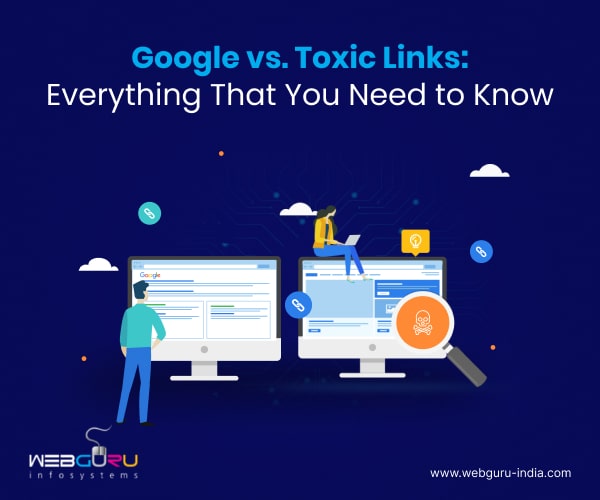Home Blog Digital Marketing Services Understanding Toxic Links and Google’s Approach to Handling Them
Understanding Toxic Links and Google’s Approach to Handling Them
- 27 Jun / 2024
- 2,602 views
- 7 Min Read

Read this blog to gain comprehensive knowledge about toxic links, such as it will help you to know how Google manages these toxic links, how they can impact your SERP ranking, and how to address them. Top digital marketing service providers have shared how Google identifies and handles such harmful backlinks. It also throws light on the basic areas and clearly defines what is a toxic link, what makes the links toxic, how they can impact your rankings, how they can be avoided, and more. Give it a read for in-depth information.
Backlinks are a wonderful way for your website to get discovered in this over-crowded digital arcade. Besides getting attention from the masses, these backlinks also help to earn credibility, and most important thing- a better SERP ranking. Hence, for online business owners, backlinks are as crucial as other Off-page SEO activities alongside On-page SEO activities.
However, while relevant backlinks can help businesses scale the SERP ladder and offer other benefits, poor backlinks can do the opposite. In this connection, every online business owner commonly remains concerned about the same. To help you to get a clear picture, in this blog top service providers offering digital marketing services have shared relevant information to help you understand what is the take of Google on this, and how it identifies and manages it.
What Are Toxic Backlinks?
Toxic links are backlinks that can negatively impact your website’s SEO. They differ from good-quality backlinks, which come from trustworthy sources and improve the authority and ranking of your site. Toxic links usually originate from suspicious, low-grade or irrelevant sites, and are generally developed with the intention to manipulate search engine algorithms and scale up the ranking.
Link Farms
These are groups of internet sites made for the sole purpose of linking to each other, aiming to manipulate search engine results.
Spammy Directories
These are low-quality directories that do not provide much benefit and are typically used only for creating links.
Irrelevant Sites
Websites that are unrelated to your industry or content, hence not contributing any real value to your SEO.
Some toxic link examples;
- Originating from sites developed for building links solely
- Received from irrelevant websites
- Links from sites that are not related to your industry
- Links from sites that are not indexed by search engines
- Irrelevant links that are forcefully inserted in the blog’s comment section
- The one link that can be found on every page of the website
What Makes a Backlink Toxic?
1. Low Domain Authority Sites
When you receive links from a site with a domain score of 40 or less, these links can be toxic, since these sites are generally developed to solely influence the rankings.
2. Mirror Pages
There are websites that are clones of certain websites or pages, consisting of the same content but other URLs. Search engines categorise these links as toxic, and if you receive links from such sites, your rankings can drop.
3. Layout
Segmentation of pages can also impact your link-building process negatively. If you are receiving these links from sites without a header, footer, or column design, or note that when a proportion of the displayed text to HTML is low, the layout is considered poor.
How Toxic Links Affect Your Website?
Top service providers offering SEO services have observed how toxic links can be damaging to your website. In this section, we have covered a few points to show how it affects your website.
Search Engine Rankings Drop
Backlinks help search engines like Google determine the trustworthiness or reliability of a website. If there are many toxic links pointing towards your site, it can result in a decrease in its rankings on search engine results pages.
Algorithmic Devaluation
This is when Google’s algorithms detect and reduce the value of websites with poor link profiles, impacting their SEO performance as well – even if there are no manual penalties.
Manual Penalties
Google can manually penalise sites with a high number of toxic links, resulting in a significant decrease in search visibility.
However, toxic links may not be affected in the same way that it did before 2016. So what changed?
Google’s algorithm update ushered in a shift from penalising pages to implementing a mechanism that disregards substandard links.
Google’s Approach to Toxic Links
Google has advanced methods for recognizing and controlling toxic links. They apply algorithmic solutions, along with webmaster tools to actively deal with these links.
Official Guidelines
The Webmaster Guidelines of Google give clear instructions on what is considered a good backlink and otherwise. Main points comprise;
- Avoiding link schemes and purchasing links.
- Ensuring backlinks come from relevant and high-quality sources.
- Check your backlink profile regularly for any suspicious activity.
Google’s Algorithms
Google’s algorithms, like Penguin, are engineered to identify and penalise sites that use manipulative practices in the process of link-building. The algorithm of Penguin focuses on websites having unnatural links, lowering the value of those links and applying penalties on such sites.
The Disavow Tool
For webmasters who need assistance in handling toxic links, Google has a Disavow Tool. This special feature lets the site owner inform Google which backlinks they wish to disavow. Essentially it means telling Google not to consider these links when evaluating the site’s SEO worthiness.
Google’s Response to Toxic Link Sabotage
Gary Illyes from Google recently provided some insights on how to deal with toxic link sabotage. This is a usual issue that occurs when competitors create harmful backlinks to wreck a site’s SEO. Gary clearly said that Google’s algorithms are extremely advanced in detecting and ignoring irrelevant and toxic links. He advised that site owners must not be too concerned about these links and suggested disavowing them as a method to be used with caution.
Gary Illyes’ Advice
Gary Illyes, a member of Google’s search team, replied to a question regarding notifying them about sabotage through toxic links by saying “I’d ignore those links.” He highlighted that Google is highly skilled in disregarding links, which are not relevant. But he also mentioned if there are certain toxic links that site owners feel strongly against, they can always disavow them or file a spam report.
How to Discover Toxic Links?
It is important to understand that in your online business journey, discovering toxic links is the first key step to managing them and scaling the SERP rankings without any setbacks. So, in this section let’s take a look at the ways suggested by top digital marketing service providers by which you can identify these types of links.
• Google Search Console
Provides insights into your backlink profile and flags potential issues.
• Ahrefs
Offers comprehensive backlink analysis and can help identify toxic links.
• SEMrush
SEMrush offers another powerful tool for backlink audits; it provides a toxicity score for each link.
• Moz
Moz’s Link Explorer is useful for evaluating the quality of your backlinks.
In order to optimise your SEO strategy, it is important to include regular site audits and report generation. During a site audit, pay attention to the sources of your links and determine their reliability. In addition, it is important to learn about link profiles and assess your total toxic score. Consider creating a whitelist of domains with low toxic scores. Once you identify poor links, develop a strategy to remove them.
How You Can Prevent Toxic Links?
We are familiar with the proverb ‘prevention is better than cure’, which applies in this case as well. Toxic links are better prevented, than dealt with. Although it sounds easy, practically it needs the right effort. In this section, we will take a look at how you can prevent these toxic links.
Best Practices
• Quality Over Quantity
Focus on acquiring high-quality backlinks from reputable sources.
• Relevant Backlinks
Ensure your backlinks come from sites relevant to your industry or niche.
• Natural Link Building
Avoid manipulative link-building practices like link schemes or purchasing links.
Proactive Measures
• Regular Monitoring
Regularly monitor your backlink profile using tools such as Google Search Console, Ahrefs, or SEMrush to stay informed.
• Disavow Suspicious Links Early
Disavow potential toxic links before they can cause harm if you identify them, pronto.
In case your site is already affected by toxic links, then here are a few effective steps that you can follow.
A Step-by-Step Guide
Identify Toxic Links
Utilise the tools and methods mentioned above to create a compilation of toxic links.
Attempt Removal
If possible try to contact the webmasters of these sites and ask them to remove these toxic links.
Google Disavow Tool
For links that are not possible to remove, you can use the Google Disavow Tool to disavow them.
Submit a Reconsideration Request
If the manual penalty is the cause for your site’s low ranking, then you must submit a reconsideration request to Google explaining what actions have been taken in order to clean up the link profile of your website.
Confirmation That Google Can Ignore Links
Over the years, Google’s ability to ignore irrelevant or harmful links has greatly improved. A notable incident from 2012 exemplifies this; a webmaster noticed a decline in their website’s rankings due to negative SEO links and contacted Google for help. After a thorough investigation, it was discovered that the drop in rankings was actually due to a Panda update that targeted content issues, not harmful links. Google’s expertise in disregarding detrimental backlinks has consistently shown remarkable effectiveness, even in the past. As their spam brain AI continues to advance, their capabilities have only been strengthened.
Conclusion
Toxic backlinks are what its name suggests. Although you must be cautious about these links and keep your site safeguarded, there is nothing to worry about. Google has confirmed that its algorithms are advanced and capable enough to ignore the links that are irrelevant. Hence site owners can leave it to Google, and the search engine will handle it. However, as per the spokesperson of Google, if the site owners feel strongly against certain toxic links, he or she can go ahead and bring it to the notice of Google by disavowing them or filing a spam report. This blog also informs readers on how to discover toxic links, and ways to prevent them. If you would like to know more, you can get in touch with top service providers offering SEO services.

Sayari Banerjee
Dedicated SEO content writer, having a penchant for knowledge, and an insatiable appetite for reading books.
4 comments
Leave a Reply

-
1000+
Happy
Clients -
25+
Countries
Served -
19+
Years of
Trust








We have reviewed the article. That’s really awesome. Please keep going.
Informative blog
This is a fantastic guide to understanding toxic links! I especially liked the breakdown of how Google identifies and handles them.
It’s reassuring to know that Google’s algorithms are getting smarter about filtering out bad backlinks. The tips for preventing toxic links are also super helpful – focusing on quality backlinks and regular monitoring are key.
Overall, this blog is a must-read for anyone who wants to protect their website’s SEO health. Thanks for sharing!
Nice blog